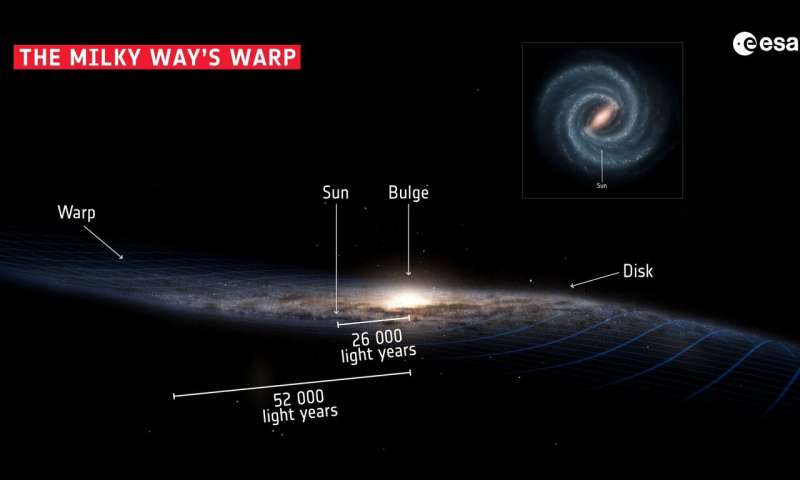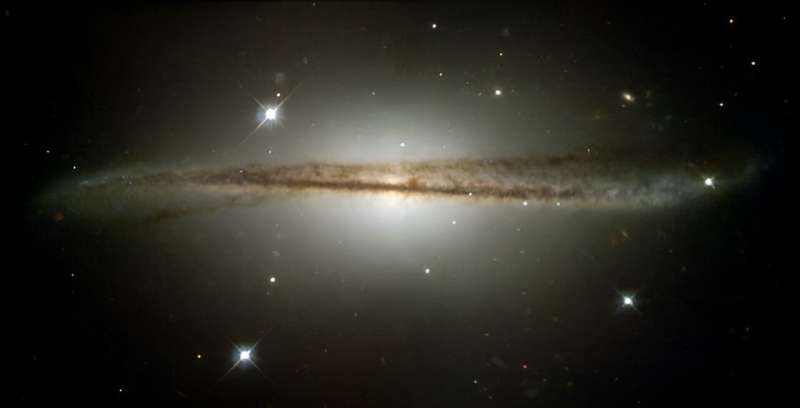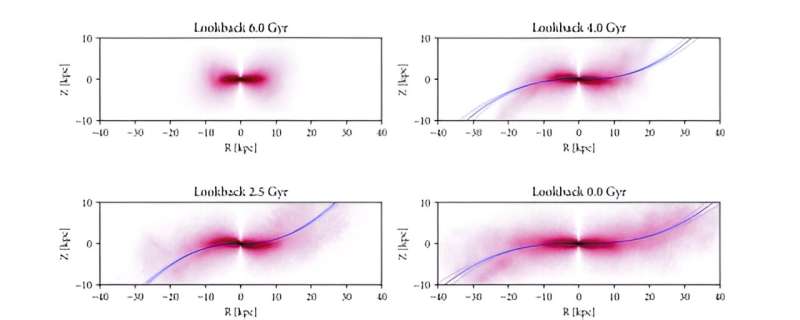This article has been reviewed according to Science X's editorial process and policies. Editors have highlighted the following attributes while ensuring the content's credibility:
fact-checked
preprint
trusted source
proofread
The Milky Way's disk is warped. Is that because its dark matter halo is tilted?

It's difficult to determine the shape of our galaxy. So difficult that only in the last century did we learn that the Milky Way is just one galaxy among billions. So it's not surprising that despite all our modern telescopes and spacecraft we are still mapping the shape of our galaxy. And one of the more interesting discoveries is that the Milky Way is warped. One explanation for this is that our galaxy has undergone collisions, but a new study posted to the arXiv preprint server argues that it's caused by dark matter.
The first evidence that the Milky Way isn't a purely flat disk came from the Gaia Spacecraft. it has mapped the positions and motions of more than a billion stars, and from this we have some idea of our galaxies outer structure. For one thing, the Milky Way seems to extend outward more than we've thought, and the edge seems to have a rippled structure to it. Further analysis also shows a warp to the outer edge of the galactic disk.
The general consensus is that these are caused by ancient galactic collisions, such as the collision with the Sagittarius dwarf galaxy about 6 billion years ago. This new study argues instead that warped galaxies such as ours are caused by a tilted halo of dark matter.

We know that most galaxies, including our own, are surrounded by a massive halo of dark matter. Most of the mass in a galaxy is contained within this halo, so halos can affect the structure of galaxies over time. If the halo is tilted relative to the plane of a galaxy, the gravitational effects of the halo could skew the galactic disk. The question is whether this is significant or common enough to cause the structure we see in the Milky Way.
The authors begin by looking at data from the TNG50 run of the IllustrisTNG simulations. These are supercomputer simulations of galactic evolution that include cosmological evolution and dark matter as well as detailed magnetohydrodynamic interactions.
From this data, the authors show that the inner region of the dark matter halo can be significantly tilted relative to the galactic plane and that these can be caused both by galactic collisions and near misses between galaxies. The orientation of the halos can persist for billions of years, which is plenty long enough to induce a galactic warp.

The team then looked at an archetypal galaxy within the TNG50 simulation, having a similar size and age to the Milky Way, including a titled dark matter halo. Based on 6 billion years of simulated evolution, the final result showed noted similarities between the observed Milky Way and the model galaxy.
Astronomers have observed other galaxies with a warped plane, and there is some evidence that as many as half of spiral galaxies in the universe are warped to some degree. This suggests the influence of long-term and common gravitational interactions between a galaxy and its twisted halo. Of course, this is just one study, so further observations and simulations will be needed to understand the details of how many galaxies such as the Milky Way evolve.
More information: Jiwon Jesse Han et al, Tilted Dark Halos are Common, Long-Lived, and can Warp Galactic Disks, arXiv (2023). DOI: 10.48550/arxiv.2309.07208
Journal information: arXiv
Provided by Universe Today


















